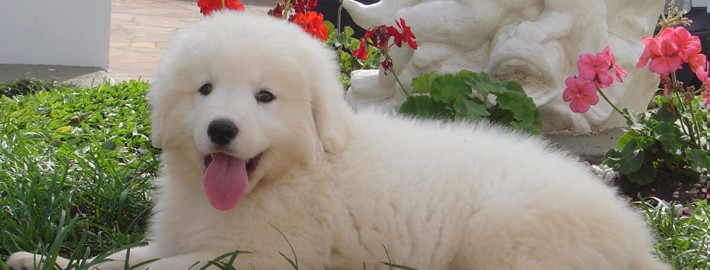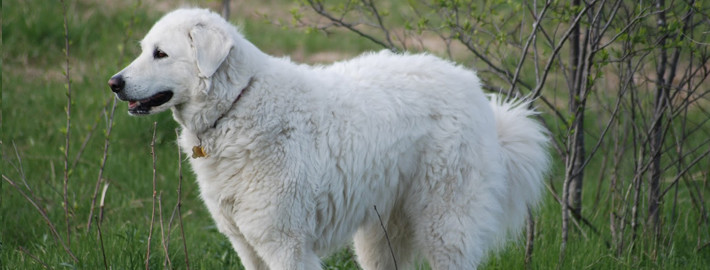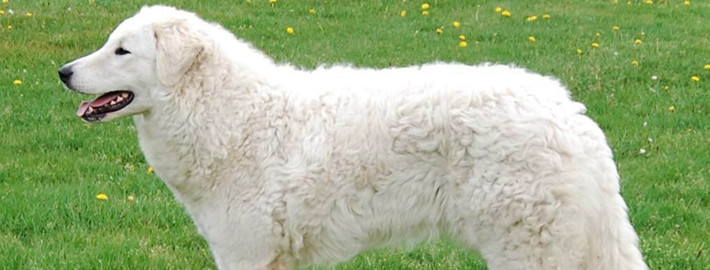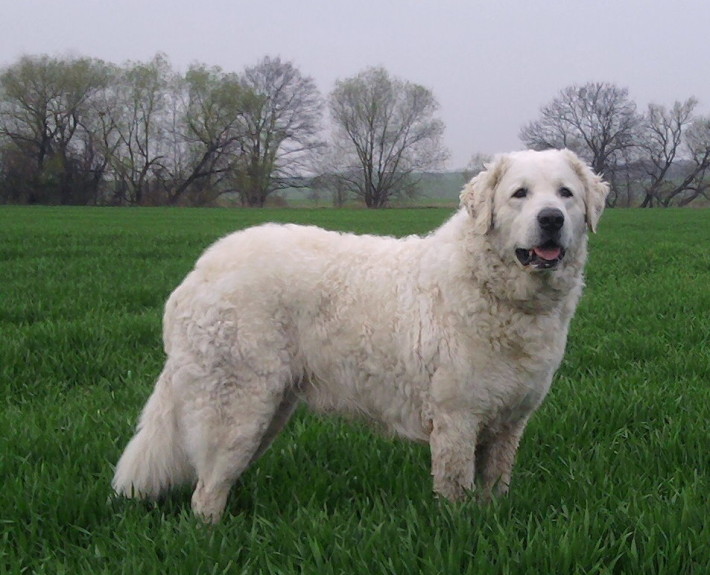What makes the Kuvasz Unique?
Considering that their name stems from a Turkish term for nobles’ guard dogs, it’s no wonder that members of this breed were popular pets with the aristocracy of their homeland.
Breed Groups
Page Contents
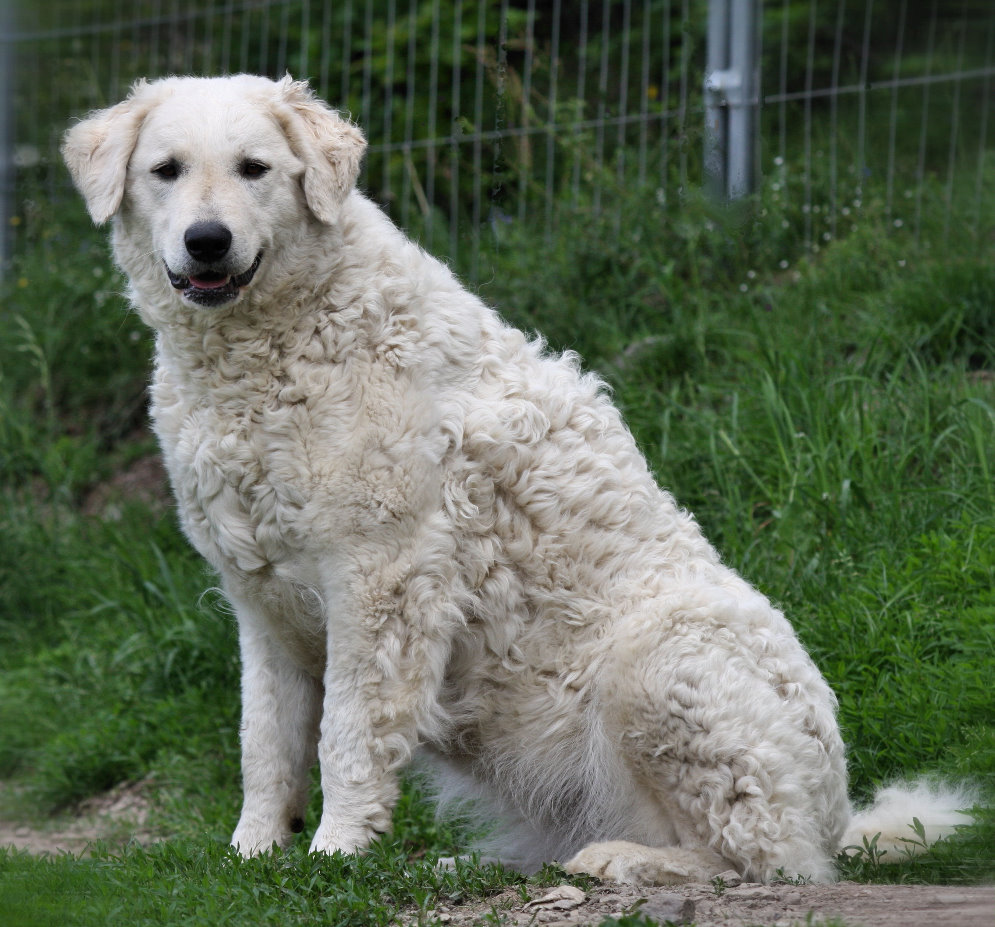
Is the Kuvasz Right For You?
Although they certainly aren’t hyper, these dogs need plenty of exercise in order to be at their best. Kuvazes also have a mischievous streak that can get them into trouble. Any food left unattended around these intelligent dogs is fair game as far as they are concerned. Members of this breed who are bored or lonely are likely to succumb to behavioral problems such as digging large holes in the yard or barking nonstop. Prospective owners should additionally be aware that Kuvazes are also known to drool and slobber, which could be problematic if household cleanliness is a major issue. Of course, these dogs are great pets under the right circumstances but if they are matched with the wrong sort of owner, they can be a great deal of trouble.
In 5 Words
- Protective
- Clownish
- Intelligent
- Loyal
- Patient
Characteristics
Learn About the Kuvasz
Description
Kuvazes are large dogs with sturdy bone structures and athletic bodies. Members of this breed are somewhat longer than they are tall. These dogs have black noses and lips. The interiors of their mouths are also black. Dark brown, almond-shaped eyes are yet another breed feature. Kuvazes have folded ears that sit close to their heads. Their lengthy, low-set tails are elevated when they are alerted by something. These dogs move with quick and easy gait that allows them to be successful at many different tasks.
Size
Male of this breed typically weigh anywhere from 100 to 115 pounds (45 to 52 kilograms) with the females being somewhat smaller at an average of 70 to 90 pounds (32 to 41 kilograms). The females of this breed are also shorter than the males as they generally stand 26 to 28 inches (65 to 70 centimeters) tall rather than the 28 to 30 inches (70 to 76 centimeters) that is customary for male Kuvazes.
Coat
Members of this breed have double layer coat that is around 4 to 6 inches (10 to 15 centimeters) centimeters long. However, these dogs tend to have shorter fur on their heads and feet that is shorter than it is on the rest of their bodies. Kuvazes typically have white fur but ivory is considered acceptable by some breed standards.
Short History of the Kuvasz
Although the Kuvasz breed counts large dogs from Tibet among their ancestors, the animals were actually developed in what is now Hungary. It is possible that the Maremma Sheepdog, the Pyrenean Mountain Dog, and the Akbash Dog were also among the ancestors of the modern day breed. During the Middle Ages, only the region’s royalty had complete access to the Kuvaszes. However, the royals did occasionally give members of this breed as gifts to their favorite courtiers.
These dogs were subsequently used for guarding large estates during the 15th century. Kuvaszes also functioned quite well as a hunting breed since the dogs were perfectly capable of tackling large prey such as bears and wolves. King Matthias was a fan of the breed and even started his own research kennels to improve their overall potential.
It was centuries later before ordinary folks were only able to get their hands on these dogs and the animals began to be used as a livestock breed. As wa the case with many breeds, the World Wars of the 20th century were responsible for a sharp decline in the overall Kuvasz population. However, there were some individuals living in Germany that were used to continue the breed. These dogs eventually made their way to America in the 1930s and were officially recognized by the American Kennel Club (AKC) in 1931.
Temperament
Members of this loyal breed make fierce guardians despite their angelic appearances. All the same, they dogs are quite gentle with members of their own family, other pets, and livestock. However, they may act aggressively towards other dogs, particularly those of their own gender. Even if they are not as openly affectionate as some breeds are, Kuvaszes will go above and beyond to defend what is theirs. Some may even decide to protect the neighbors’ yards so it is best if these dogs are kept leashed or kept in a safely enclosed area. Members of this breed get along just fine out of doors but they are sociable creatures that would prefer to live inside with their human owners if there is no reason for them to remain outside.
Caution should always be exercised when other children come into the picture because these dogs might view kids’ general roughhousing as an attack on someone that is under their protection. Members of this breed are particularly wary of unfamiliar people and they are also known to attack strange dogs. Kuvazes can quickly become bossy if they are allowed to have their own way. It is therefore important to begin training them at a young age.. Prospective owners should also be aware that members of this breed are one family dogs. They should be prepared to care for their Kuvasz for the entirety of its life, because this trait significantly reduces an animal’s chances of being adopted in the future if its family decides to surrender it.
Although they certainly aren’t hyper, these dogs need plenty of exercise in order to be at their best. Kuvazes also have a mischievous streak that can get them into trouble. Any food left unattended around these intelligent dogs is fair game as far as they are concerned. Members of this breed who are bored or lonely are likely to succumb to behavioral problems such as digging large holes in the yard or barking nonstop. Prospective owners should additionally be aware that Kuvazes are also known to drool and slobber, which could be problematic if household cleanliness is a major issue. Of course, these dogs are great pets under the right circumstances but if they are matched with the wrong sort of owner, they can be a great deal of trouble.
Caring for Your Kuvasz
General Health
Members of this breed typically have a lifespan of 10 to 12 years. Prospective owners should nonetheless keep an eye out for health problems such as hypertrophic osteodystrophy, hip dysplasia, and skin allergies which can arise from time to time.
Care
Daily
Kuvaszes were bred to be working dogs and they subsequently need regular, vigorous workout sessions in order to be at their best. Owners should be prepared to accompany their pet on brisk walks or long jogs every day if the dog in question is not serving as a livestock manager. Proper leash training is also essential to avoid behavioral problems with this breed.
Weekly
Kuvaszes should have their teeth cleaned on a regular basis to keep them in good oral health. This can be accomplished using a pet approved toothbrush and toothpaste. Tooth powders or specially formulated bones may also help in this regard. A once weekly brushing of their thick, white coat is also necessary.
Monthly
All dogs need parasite prevention medications to keep harmful pests at bay and these products are generally administered at least once per month.
Grooming & Bathing
These dogs have a coat that naturally repels dirt and they do not need to be bathed with any regularity. In fact, too much scrubbing can strip the protective oils from their coats that help them withstand the elements. However, shedding can be a bit of a problem for this breed. Kuvaszes living in northern regions will likely lose a lot of fur on a seasonal basis but dogs in southern regions are likely to shed on a year round basis. Regular grooming may help keep households from becoming covered with fur. It is also a good idea to get these dogs used to having their nails trimmed and their teeth cleaned when they are puppies to avoid problems in this regard when they get to be older.
Exercise & Training
These dogs require early obedience training and socialization if they are to become productive members of society. Owners that plan on having their Kuvasz manage livestock will naturally require even more training than those who are cossetted family pets. Proper socialization helps keep these naturally suspicious dogs from thinking that they are surrounded by threats and acting accordingly.
Meanwhile, strong leadership is important where these stubborn dogs are concerned because if they are allowed to manage their households, they will do so with great relish. This in turn can cause the animal in question to become wild and uncontrollable. Patience is also needed because members of this breed do not mature as quickly as other dog varieties. Even generally well-behaved Kuvaszes may challenge their owners’ leadership on occasion. As a result, this breed is probably not a good choice for amateur or weak-willed pet owners.

